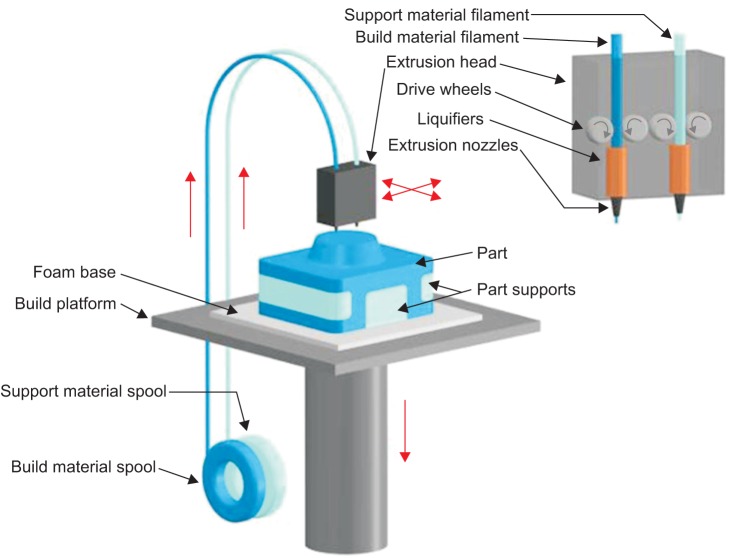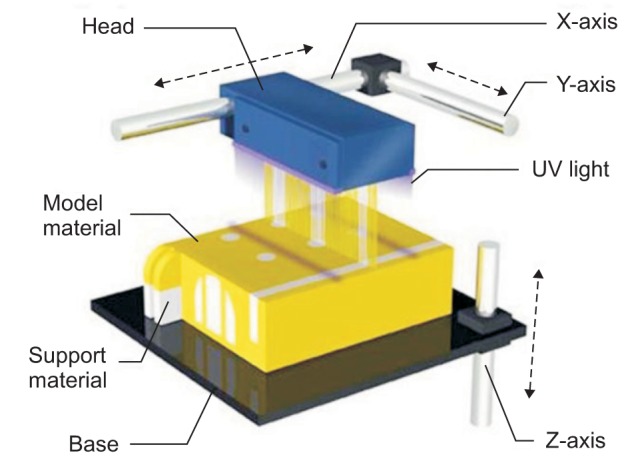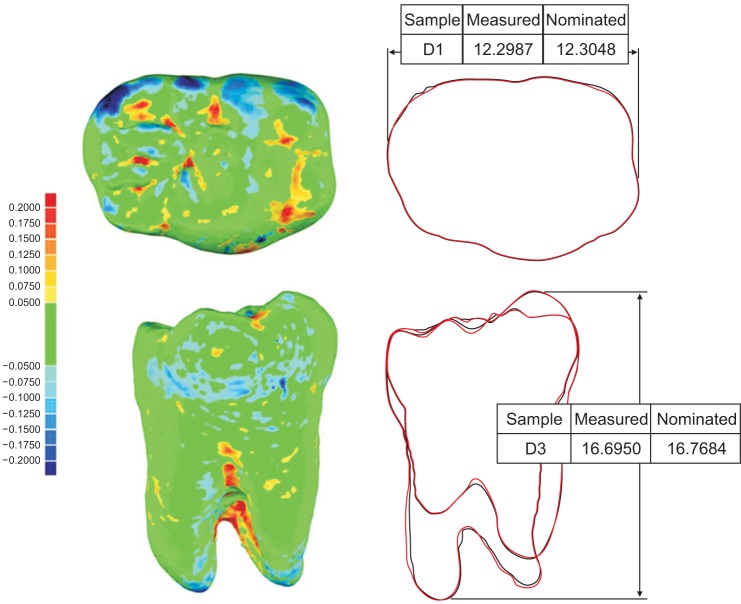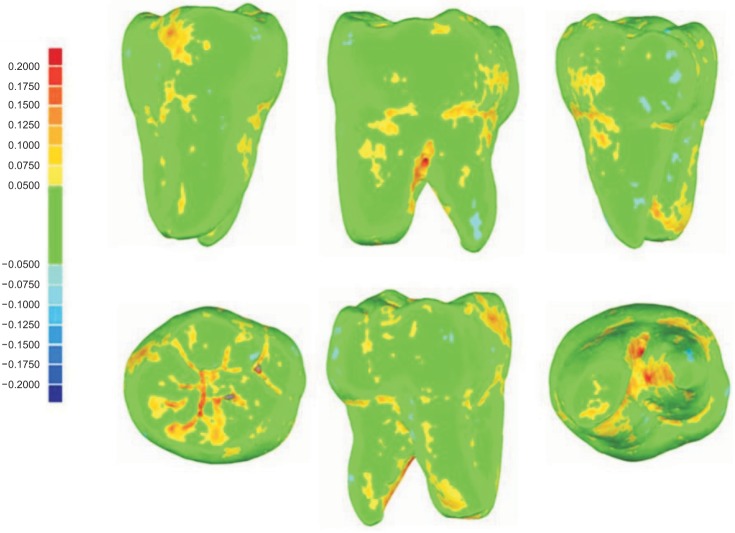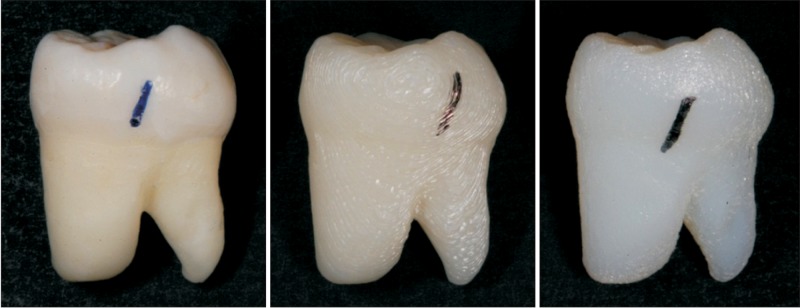Korean J Orthod.
2015 Sep;45(5):217-225. 10.4041/kjod.2015.45.5.217.
Accuracy of three-dimensional printing for manufacturing replica teeth
- Affiliations
-
- 1Department of Orthodontics, Wonkwang University Daejeon Dental Hospital, Daejeon, Korea.
- 2Department of Orthodontics, Wonkwang University Dental Hospital, Iksan, Korea.
- 3Department of Orthodontics, Wonkwang University Sanbon Dental Hospital, Sanbon, Korea. jjhdent@wonkwang.ac.kr
- KMID: 2068516
- DOI: http://doi.org/10.4041/kjod.2015.45.5.217
Abstract
OBJECTIVE
Three-dimensional (3D) printing is a recent technological development that may play a significant role in orthodontic diagnosis and treatment. It can be used to fabricate skull models or study models, as well as to make replica teeth in autotransplantation or tooth impaction cases. The aim of this study was to evaluate the accuracy of fabrication of replica teeth made by two types of 3D printing technologies.
METHODS
Fifty extracted molar teeth were selected as samples. They were scanned to generate high-resolution 3D surface model stereolithography files. These files were converted into physical models using two types of 3D printing technologies: Fused deposition modeling (FDM) and PolyJet technology. All replica teeth were scanned and 3D images generated. Computer software compared the replica teeth to the original teeth with linear measurements, volumetric measurements, and mean deviation measurements with best-fit alignment. Paired t-tests were used to statistically analyze the measurements.
RESULTS
Most measurements of teeth formed using FDM tended to be slightly smaller, while those of the PolyJet replicas tended to be slightly larger, than those of the extracted teeth. Mean deviation measurements with best-fit alignment of FDM and PolyJet group were 0.047 mm and 0.038 mm, respectively. Although there were statistically significant differences, they were regarded as clinically insignificant.
CONCLUSIONS
This study confirms that FDM and PolyJet technologies are accurate enough to be usable in orthodontic diagnosis and treatment.
Keyword
Figure
Reference
-
1. Park YS, Jung MH, Shon WJ. Autotransplantion of a displaced mandibular second premolar to its normal position. Am J Orthod Dentofacial Orthop. 2013; 143:274–280. PMID: 23374935.
Article2. Shahbazian M, Wyatt J, Willems G, Jacobs R. Clinical application of a stereolithographic tooth replica and surgical guide in tooth autotransplantation. Virtual Phys Prototyp. 2012; 7:211–218.
Article3. Honda M, Uehara H, Uehara T, Honda K, Kawashima S, Honda K, et al. Use of a replica graft tooth for evaluation before autotransplantation of a tooth. A CAD/CAM model produced using dental-cone-beam computed tomography. Int J Oral Maxillofac Surg. 2010; 39:1016–1019. PMID: 20630704.
Article4. Lee SJ, Jung IY, Lee CY, Choi SY, Kum KY. Clinical application of computer-aided rapid prototyping for tooth transplantation. Dent Traumatol. 2001; 17:114–119. PMID: 11499760.
Article5. Faber J, Berto PM, Quaresma M. Rapid prototyping as a tool for diagnosis and treatment planning for maxillary canine impaction. Am J Orthod Dentofacial Orthop. 2006; 129:583–589. PMID: 16627189.
Article6. Stampfl J, Liska R. New materials for rapid prototyping applications. Macromol Chem Phys. 2005; 206:1253–1256.
Article7. Liu Q, Leu MC, Schmitt SM. Rapid prototyping in dentistry: technology and application. Int J Adv Manuf Technol. 2006; 29:317–335.
Article8. Azari A, Nikzad S. The evolution of rapid prototyping in dentistry: a review. Rapid Prototyp J. 2009; 15:216–225.
Article9. Kim JH, Kim KB, Kim WC, Kim JH, Kim HY. Accuracy and precision of polyurethane dental arch models fabricated using a three-dimensional subtractive rapid prototyping method with an intraoral scanning technique. Korean J Orthod. 2014; 44:69–76. PMID: 24696823.
Article10. Keating AP, Knox J, Bibb R, Zhurov AI. A comparison of plaster, digital and reconstructed study model accuracy. J Orthod. 2008; 35:191–201. PMID: 18809782.
Article11. Cuperus AM, Harms MC, Rangel FA, Bronkhorst EM, Schols JG, Breuning KH. Dental models made with an intraoral scanner: a validation study. Am J Orthod Dentofacial Orthop. 2012; 142:308–313. PMID: 22920696.12. Kasparova M, Grafova L, Dvorak P, Dostalova T, Prochazka A, Eliasova H, et al. Possibility of reconstruction of dental plaster cast from 3D digital study models. Biomed Eng Online. 2013; 12:49. PMID: 23721330.
Article13. Hazeveld A, Huddleston Slater JJ, Ren Y. Accuracy and reproducibility of dental replica models reconstructed by different rapid prototyping techniques. Am J Orthod Dentofacial Orthop. 2014; 145:108–115. PMID: 24373661.
Article14. Stanek M, Manas D, Manas M, Navratil J, Kyas K, Senkerik V, et al. Comparison of different rapid prototyping methods. Intern J Math Comput Simul. 2012; 6:550–557.15. Park HM. Comparing group means: T-tests and One-way ANOVA, Using Stata, SAS, R, and SPSS, Working Paper. Bloomington, IN: The University Information Technology Services Center for Statistical and Mathematical Computing, Indiana University;2009.16. Lilliefors HW. On the Kolmogorov-Smirnov test for normality with mean and variance unknown. J Am Stat Assoc. 1967; 62:399–402.
Article17. Müller R, Büttner P. A critical discussion of intraclass correlation coefficients. Stat Med. 1994; 13:2465–2476. PMID: 7701147.
Article18. Bell A, Ayoub AF, Siebert P. Assessment of the accuracy of a three-dimensional imaging system for archiving dental study models. J Orthod. 2003; 30:219–223. PMID: 14530419.
Article19. Barker TM, Earwaker WJ, Lisle DA. Accuracy of stereolithographic models of human anatomy. Australas Radiol. 1994; 38:106–111. PMID: 8024501.
Article20. Murugesan K, Anandapandian PA, Sharma SK, Vasantha Kumar M. Comparative evaluation of dimension and surface detail accuracy of models produced by three different rapid prototype techniques. J Indian Prosthodont Soc. 2012; 12:16–20. PMID: 23449946.
Article21. Cheah CM, Chua CK, Tan KH, Teo CK. Integration of laser surface digitizing with CAD/CAM techniques for developing facial prostheses. Part 1: Design and fabrication of prosthesis replicas. Int J Prosthodont. 2003; 16:435–441. PMID: 12956501.
- Full Text Links
- Actions
-
Cited
- CITED
-
- Close
- Share
- Similar articles
-
- Emergence of Three-Dimensional Printing Technology and Its Utility in Spine Surgery
- Fabrication of additive manufacturing interim denture and comparison with conventional interim denture: A case report
- Fabrication of complete denture using 3D printing: a case report
- Application of 3-dimensional printing implants for bone tumors
- Three-dimensional printing for craniomaxillofacial regeneration

